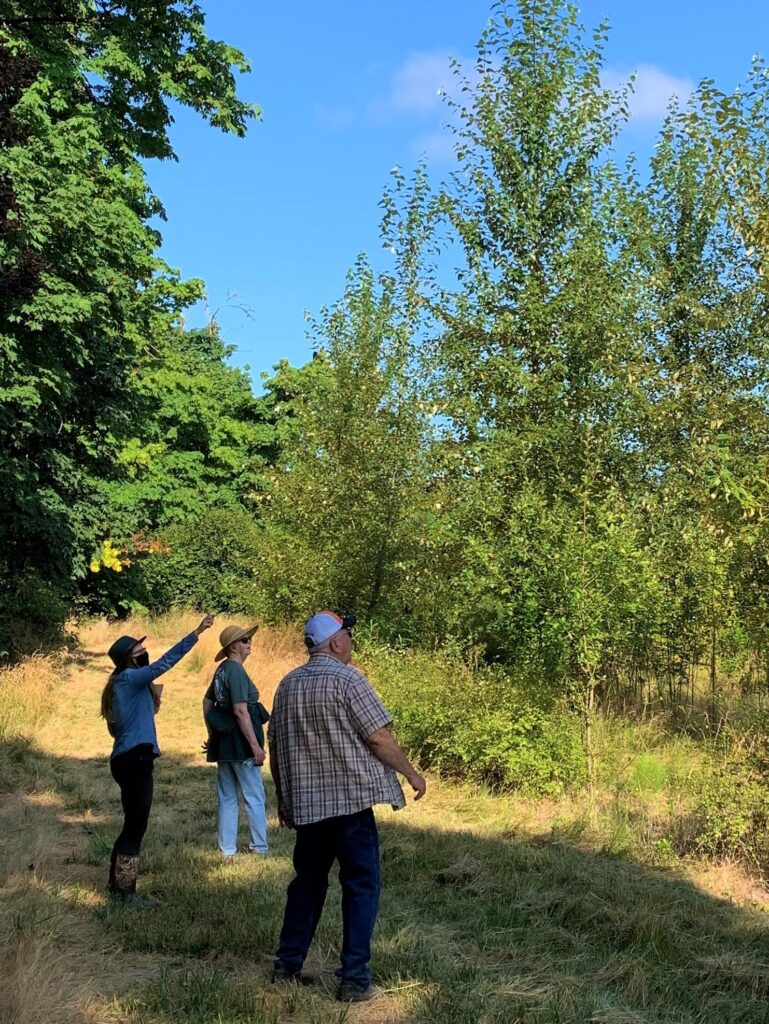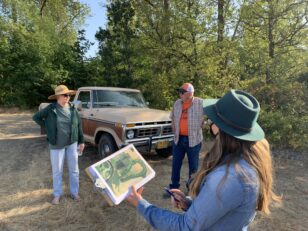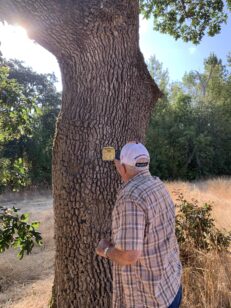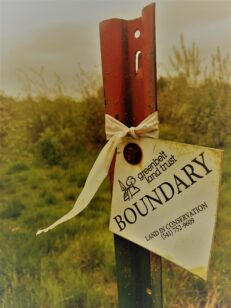Throughout the year, our conservation and stewardship staff, volunteers, and partners from various agencies and organizations are busy monitoring birds, turtles, the success of restoration plantings, and the status of invasive weeds on the properties we protect. Monitoring is done on foot, with drones, and with remote cameras. In addition to monitoring these components of our conservation work, we also perform annual monitoring of each property as a whole. Every property we protect, whether we hold title to the land or a conservation easement, is visited and evaluated annually.
 As land restoration work winds down at the end of the summer, autumn is traditionally the time for monitoring visits to our conservation easements. Conservation Coordinator Claire Fox is getting a jump on monitoring in 2020 and has started the yearly round of visiting the properties we protect with conservation easements, a task that she enjoys for the interaction with nature and with people.
As land restoration work winds down at the end of the summer, autumn is traditionally the time for monitoring visits to our conservation easements. Conservation Coordinator Claire Fox is getting a jump on monitoring in 2020 and has started the yearly round of visiting the properties we protect with conservation easements, a task that she enjoys for the interaction with nature and with people.
“My favorite part of monitoring easements is getting outside with people on their land. I like to hear the stories about what makes this place special — whether it is a favorite tree, a neat habitat project, or a family memory of time spent outside. You really learn that for some people, caring for their land is a labor of love.”
A conservation easement is a legal agreement between a land trust and a willing landowner that protects a property’s conservation values forever. The landowner sells, or more commonly donates the easement to the land trust and relinquishes the right to take actions that would lower the ecological values of the land. Typical restrictions include commercial logging, mining, and large scale development.
Conservation easements are entered into with landowners who want to see their properties remain unchanged in the future. Conservation easements must provide public benefits such as water quality, agricultural and scenic values, or wildlife habitat. Economic benefits to the landowner may be realized through tax benefits and estate planning. Floodplains, wetlands, riparian areas, healthy soil and productive farmland, big trees and prairie wildflowers – conservation easements can protect it all!
A conservation easement transfers with ownership, ensuring that the holder of the easement can continue to protect and maintain the important ecological values. Greenbelt holds 27 conservation easements protecting farms, forests, prairie, and wetlands across the Mid-Willamette Valley. Part of our job in holding a conservation easement is to make sure that the terms of the easement are being upheld and that the conservation values of the property continue to be protected. We accomplish this through annual monitoring.
 Monitoring Season
Monitoring SeasonEvery year we pay a visit to each property to monitor the easement. We have a conversation with the landowner to talk about their land management goals, address any concerns that they have or we have, and share updates. Then we walk the boundaries of the property and visit the major features to monitor habitat dynamics and identify any threats or changes.
Noteworthy changes are documented with notes and photographs in a monitoring report. We keep all of this information in a permanent file to document the condition of the property over time.
The collaborative partnerships we have with our easement landowners allow us to protect much more than just the lands we could purchase outright. Private landowners who want to see the ecological values of their land remain intact have protected nearly 9 million acres in the U.S. through conservation easements.

Horseshoe Lake
Greenbelt Land Trust has been monitoring some of our easements for over 25 years! Properties have passed on to new landowners over the years but the ecological values and protections are left intact. We are committed to protecting the natural values and public benefits of these special places in perpetuity.

Throughout the year, our conservation and stewardship staff, volunteers, and partners from various agencies and organizations are busy monitoring birds, turtles, the success of restoration plantings, and the status of invasive weeds on the properties we protect. Monitoring is done on foot, with drones, and with remote cameras. In addition to monitoring these components of our conservation work, we also perform annual monitoring of each property as a whole. Every property we protect, whether we hold title to the land or a conservation easement, is visited and evaluated annually.

Conservation Coordinator Claire Fox
As land restoration work winds down at the end of the summer, autumn is traditionally the time for monitoring visits to our conservation easements. Conservation Coordinator Claire Fox is getting a jump on monitoring in 2020 and has started the yearly round of visiting the properties we protect with conservation easements.
A conservation easement is a legal agreement between a land trust and a willing landowner that protects a property’s conservation values forever. The landowner sells, or more commonly donates the easement to the land trust and relinquishes the right to take actions that would lower the ecological values of the land. Typical restrictions include commercial logging, mining, and large scale development.
Conservation easements are entered into with landowners who want to see their properties remain unchanged in the future. Conservation easements must provide public benefits such as water quality, agricultural and scenic values, or wildlife habitat. Economic benefits to the landowner may be realized through tax benefits and estate planning. Floodplains, wetlands, and riparian areas, healthy soil and productive farmland, big trees and prairie wildflowers – conservation easements can protect it all!

Horseshoe Lake
A conservation easement transfers with ownership, ensuring that the holder of the easement can continue to protect and maintain the important ecological values. Greenbelt holds 27 conservation easements protecting farms, forests, prairie, and wetlands across the Mid-Willamette Valley. Part of our job in holding a conservation easement is to make sure that the terms of the easement are being upheld and that the conservation values of the property continue to be protected. We accomplish this through annual monitoring.
 Monitoring Season
Monitoring SeasonEvery year we pay a visit to each property to monitor the easement. We have a conversation with the landowner to talk about their land management goals, address any concerns that they have or we have, and share updates. Then we walk the boundaries of the property and visit the major features to monitor habitat dynamics and identify any threats or changes.
Noteworthy changes are documented with notes and photographs in a monitoring report. We keep all of this information in a permanent file to document the condition of the property over time.

The collaborative partnerships we have with our easement landowners allow us to protect much more than just the lands we could purchase outright. Private landowners who want to see the ecological values of their land remain intact have protected nearly 9 million acres in the U.S. through conservation easements.
Greenbelt Land Trust has been monitoring some of our easements for over 25 years! Properties have passed on to new landowners over the years but the ecological values and protections are left intact. We are committed to protecting the natural values and public benefits of these special places and in perpetuity.
